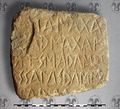TV-1.1: Difference between revisions
No edit summary |
No edit summary |
||
| Line 13: | Line 13: | ||
|craftsmanship=engraved | |craftsmanship=engraved | ||
|condition=damaged, fragmentary | |condition=damaged, fragmentary | ||
|checklevel= | |checklevel=3 | ||
|problem=bitte eine fachmeinung, Sartori (Publikationsgeschichte) | |problem=bitte eine fachmeinung, Sartori (Publikationsgeschichte), wieso ist Pellegrini 1964 vor Sartori?? | ||
|disambiguation=TV-1 | |disambiguation=TV-1 | ||
}} | }} | ||
| Line 22: | Line 22: | ||
Pictures in {{bib|Pellegrini & Prosdocimi 1967}}: 400 (photo) and {{bib|Morandi 1999}}: fig. 32 and 33 (photos) and 34 (drawing). | Pictures in {{bib|Pellegrini & Prosdocimi 1967}}: 400 (photo) and {{bib|Morandi 1999}}: fig. 32 and 33 (photos) and 34 (drawing). | ||
The Latin inscription was only detected after the slab had been taken out of the church wall, where it had been placed with the [[index::TV-1.2|allegedly Raetic inscription]] facing outward. Although {{bib|Pellegrini 1964|Pellegrini}} mentioned the possibility of a bilingua and expressed his hope for the Latin text shedding light on the Raetic, '''Sartori'''. After this, the text is noted and reproduced in the {{bib|Pellegrini & Prosdocimi 1967|Lingua Venetica}} with the comment "di dubbia trascrizione" (p. 400); similarly, {{bib|LIR|Mancini}} refers to "un'iscrizione di età romana di difficile lettura" (p. 278). | |||
The first to attempt a reading and interpretation was Alessandro {{bib|Morandi 1999|Morandi}} (pp. 99 ff.) | The first to attempt a reading and interpretation was Alessandro {{bib|Morandi 1999|Morandi}} (pp. 99 ff.) | ||
{{bibliography}} | {{bibliography}} | ||
Revision as of 20:42, 29 October 2014
| Inscription | |
|---|---|
| Transliteration: | ? |
| Original script: | ? |
|
| |
| Object: | TV-1 slab (sandstone) (Inscriptions: TV-1.1, TV-1.2) |
| Position: | |
| Script: | Latin script |
| Direction of writing: | dextroverse |
| Letter height: | 33 cm <br /> – 4 cm |
| Craftsmanship: | engraved |
| Current condition: | damaged, fragmentary |
| Date of inscription: | |
| Date derived from: | |
|
| |
| Language: | unknown |
| Meaning: | unknown |
|
| |
| Alternative sigla: | none |
Images
Commentary
First published by Sartori 1951: 14 f.
Pictures in Pellegrini & Prosdocimi 1967: 400 (photo) and Morandi 1999: fig. 32 and 33 (photos) and 34 (drawing).
The Latin inscription was only detected after the slab had been taken out of the church wall, where it had been placed with the allegedly Raetic inscription facing outward. Although Pellegrini mentioned the possibility of a bilingua and expressed his hope for the Latin text shedding light on the Raetic, Sartori. After this, the text is noted and reproduced in the Lingua Venetica with the comment "di dubbia trascrizione" (p. 400); similarly, Mancini refers to "un'iscrizione di età romana di difficile lettura" (p. 278).
The first to attempt a reading and interpretation was Alessandro Morandi (pp. 99 ff.)
Bibliography
| IR | Alberto Mancini, "Iscrizioni retiche", Studi Etruschi 43 (1975), 249–306. |
|---|---|
| Lejeune 1951 | Michel Lejeune, "L'Inscription Rétique de Castelcies", Studi Etruschi 21 (1951), 209–214. |
| LIR | Alberto Mancini, Le Iscrizioni Retiche [= Quaderni del dipartimento di linguistica, Università degli studi di Firenze Studi 8–9], Padova: Unipress 2009–10. (2 volumes) |

